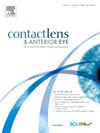干眼症和良性本质性眼睑痉挛患者上眼睑压力和眼表参数的比较:一项横断面研究。
IF 4.1
3区 医学
Q1 OPHTHALMOLOGY
引用次数: 0
摘要
目的:比较干眼症(DED)和伴有良性眼睑痉挛(BEB)的DED之间的上眼睑压(UEP)和眼表参数,探讨哪些参数可以帮助区分DED和BEB,并作为伴有BEB的DED的潜在风险因素:方法:所有被诊断为 DED 或 DED 并发 BEB 的参试者首先接受眼表疾病指数(OSDI)测定。随后,使用创新的眼睑压力测量装置记录上眼睑压力,并进行一系列眼表检查。采用独立 t 检验和 Mann-Whitney U 检验对两组患者进行比较。为了确定哪些参数可以预测眼睑痉挛的发生,还进行了逻辑回归分析:结果:BEB 组的上眼睑压力更高(101.9 ± 23.5mN vs 88.4 ± 18.1mN,P = 0.009),总眨眼次数更少(6.2 ± 4.2 vs 7.1 ± 4.1,P = 0.016),角膜荧光素染色评分更高(4.0 ± 1.9 vs 3.0 ± 1.7,P = 0.046),部分眨眼率较高(0.9 ± 0.2 vs 0.5 ± 0.4,P = 0.000),以及与 DED 组相比,睑板腺分泌率(1(1,2) vs 2(1,3),P = 0.000)和睑板腺质量(1(1,1) vs 1(1,1),P = 0.033)等级较低。上眼睑压力(OR = 1.123)、部分眨眼率(OR = 0.014)和睑板腺分泌物等级(OR = 10.804)与 BEB 有显著相关性(P 结论:尽管 OSDI 评分与 DED 组相似,但 DED 组的上眼睑压力、部分眨眼率和睑板腺分泌物等级与 BEB 有显著相关性:尽管OSDI评分相似,但与单纯DED相比,DED合并BEB表现出更高的上眼睑压力、更低的角膜荧光素染色评分、更低的部分眨眼率、更多的总眨眼次数、更低的睑板腺分泌度等级以及更低的睑板腺质量。其中,较高的上眼睑压力、较低的部分眨眼率和较差的睑板腺分泌物质量被确定为 DED 中 BEB 的风险因素。本文章由计算机程序翻译,如有差异,请以英文原文为准。
Comparison of upper eyelid pressure and ocular surface parameters in dry eye disease and benign essential Blepharospasm: A cross-sectional study
Purpose
To compare the upper eyelid pressure (UEP) and ocular surface parameters between dry eye disease (DED) and DED coexisting with benign essential blepharospasm (BEB), exploring which parameters could assist in distinguishing between DED and BEB, as potential risk factors for DED with BEB.
Methods
All enrolled participants diagnosed with DED or DED coexisting with BEB were initially subjected to ocular surface disease index (OSDI) determination. Subsequently, the upper eyelid pressure was recorded using an innovative eyelid pressure measurement device, followed by a series of ocular surface examinations. The two groups were compared using the independent t-test and Mann-Whitney U test. A logistic regression analysis was performed to identify which parameters can predict the onset of blepharospasm.
Results
The BEB group achieved a higher upper eyelid pressure (101.9 ± 23.5mN vs 88.4 ± 18.1mN, P = 0.009), lower number of total blink (6.2 ± 4.2 vs 7.1 ± 4.1, P = 0.016), higher corneal fluorescein staining score (4.0 ± 1.9 vs 3.0 ± 1.7, P = 0.046), higher partial blink rate (0.9 ± 0.2 vs 0.5 ± 0.4, P = 0.000) and the lower grade of meibum expressibility (1 (1, 2) vs 2 (1, 3), P = 0.000) and meibum quality (1 (1, 1) vs 1 (1, 1), P = 0.033) compared with the DED group. The upper eyelid pressure (OR = 1.123), partial blink rate (OR = 0.014) and the grade of meibum expressibility (OR = 10.804) showed significant associations with BEB (P < 0.05).
Conclusion
Despite similar OSDI scores, DED coexisting with BEB exhibited higher upper eyelid pressure, lower corneal fluorescein staining score, lower partial blink rate, more total blinks, lower grades of meibum expressibility, and lower meibum quality compared to DED alone. Among these, higher upper eyelid pressure, lower partial blink rate, and worse grade of meibum expressibility were identified as risk factors for BEB in DED.
求助全文
通过发布文献求助,成功后即可免费获取论文全文。
去求助
来源期刊

Contact Lens & Anterior Eye
OPHTHALMOLOGY-
CiteScore
7.60
自引率
18.80%
发文量
198
审稿时长
55 days
期刊介绍:
Contact Lens & Anterior Eye is a research-based journal covering all aspects of contact lens theory and practice, including original articles on invention and innovations, as well as the regular features of: Case Reports; Literary Reviews; Editorials; Instrumentation and Techniques and Dates of Professional Meetings.
 求助内容:
求助内容: 应助结果提醒方式:
应助结果提醒方式:


